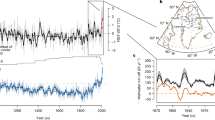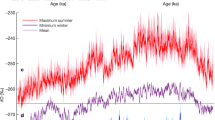Abstract
Changes in solar activity have previously been proposed to cause decadal- to millennial-scale fluctuations in both the modern and Holocene climates1. Direct observational records of solar activity, such as sunspot numbers, exist for only the past few hundred years, so solar variability for earlier periods is typically reconstructed from measurements of cosmogenic radionuclides such as 10Be and 14C from ice cores and tree rings2,3. Here we present a high-resolution 10Be record from the ice core collected from central Greenland by the Greenland Ice Core Project (GRIP). The record spans from 22,500 to 10,000 years ago, and is based on new and compiled data4,5,6. Using 14C records7,8 to control for climate-related influences on 10Be deposition, we reconstruct centennial changes in solar activity. We find that during the Last Glacial Maximum, solar minima correlate with more negative δ18O values of ice and are accompanied by increased snow accumulation and sea-salt input over central Greenland. We suggest that solar minima could have induced changes in the stratosphere that favour the development of high-pressure blocking systems located to the south of Greenland, as has been found in observations and model simulations for recent climate9,10. We conclude that the mechanism behind solar forcing of regional climate change may have been similar under both modern and Last Glacial Maximum climate conditions.
This is a preview of subscription content, access via your institution
Access options
Subscribe to this journal
Receive 12 print issues and online access
$259.00 per year
only $21.58 per issue
Buy this article
- Purchase on Springer Link
- Instant access to full article PDF
Prices may be subject to local taxes which are calculated during checkout




Similar content being viewed by others
References
Gray, L. J. et al. Solar influences on climate. Rev. Geophys. 48, RG4001 (2010).
Lal, D. & Peters, B. in Handbuch der Physik. Band XLVI/2 (eds Fluegge, S. & Sitte, K.) 551–612 (Springer, 1968).
Steinhilber, F. et al. 9,400 years of cosmic radiation and solar activity from ice cores and tree rings. Proc. Natl Acad. Sci. USA 109, 5967–5971 (2012).
Muscheler, R. et al. Changes in the carbon cycle during the last deglaciation as indicated by the comparison of Be-10 and C-14 records. Earth Planet. Sci. Lett. 219, 325–340 (2004).
Yiou, F. et al. Beryllium 10 in the Greenland Ice Core Project ice core at Summit, Greenland. J. Geophys. Res. 102, 26783–26794 (1997).
Finkel, R. C. & Nishiizumi, K. Beryllium 10 concentrations in the Greenland Ice Sheet Project 2 ice core from 3–40 ka. J. Geophys. Res. 102, 26699–26706 (1997).
Reimer, P. J. et al. IntCal 13 and Marine 13 radiocarbon age calibration curves 0–50,000 years cal BP. Radiocarbon 55, 1869–1887 (2013).
Southon, J., Noronha, A. L., Cheng, H., Edwards, R. L. & Wang, Y. A high-resolution record of atmospheric 14C based on Hulu Cave speleothem H82. Quat. Sci. Rev. 33, 32–41 (2012).
Woollings, T., Lockwood, M., Masato, G., Bell, C. & Gray, L. Enhanced signature of solar variability in Eurasian winter climate. Geophys. Res. Lett. 37, L20805 (2010).
Moffa-Sanchez, P., Born, A., Hall, I. R., Thornalley, D. J. R. & Barker, S. Solar forcing of North Atlantic surface temperature and salinity over the past millennium. Nature Geosci. 7, 275–278 (2014).
Heikkilä, U. & Smith, A. M. Production rate and climate influences on the variability of 10Be deposition simulated by ECHAM5-HAM: Globally, in Greenland, and in Antarctica. J. Geophys. Res. 118, 2506–2520 (2013).
Masarik, J. & Beer, J. An updated simulation of particle fluxes and cosmogenic nuclide production in the Earth’s atmosphere. J. Geophys. Res. 114, D11103 (2009).
Wagner, G. et al. Presence of the solar de Vries cycle (∼205 years) during the last ice age. Geophys. Res. Lett. 28, 303–306 (2001).
Blockley, S. P. E. et al. Synchronisation of palaeoenvironmental records over the last 60,000 years, and an extended INTIMATE event stratigraphy to 48,000 b2k. Quat. Sci. Rev. 36, 2–10 (2012).
Ineson, S. et al. Solar forcing of winter climate variability in the Northern Hemisphere. Nature Geosci. 4, 753–757 (2011).
Alley, R. B. et al. Changes in continental and sea-salt atmospheric loadings in central Greenland during the most recent deglaciation: Model-based estimates. J. Glaciol. 41, 503–514 (1995).
Mayewski, P. A. et al. Major features and forcing of high-latitude northern hemisphere atmospheric circulation using a 110,000-year-long glaciochemical series. J. Geophys. Res. 102, 26345–26366 (1997).
Siegenthaler, U. Uptake of excess CO2 by an outcrop-diffusion model of the ocean. J. Geophys. Res. 88, 3599–3608 (1983).
Snowball, I. & Muscheler, R. Palaeomagnetic intensity data: An Achilles heel of solar activity reconstructions. The Holocene 17, 851–859 (2007).
Muscheler, R. & Heikkilä, U. Constraints on long-term changes in solar activity from the range of variability of cosmogenic radionuclide records. Astrophys. Space Sci. Trans. 7, 355–364 (2011).
Johnsen, S. J. et al. The δ18O record along the Greenland Ice Core Project deep ice core and the problem of possible Eemian climatic instability. J. Geophys. Res. 102, 26397–26410 (1997).
Stuiver, M., Braziunas, T. F., Grootes, P. M. & Zielinski, G. A. Is there evidence for solar forcing of climate in the GISP2 oxygen isotope record? Quat. Res. 48, 259–266 (1997).
Compo, G. P. et al. The twentieth century reanalysis project. Q. J. R. Meteorol. Soc. 137, 1–28 (2011).
Rivière, G., Laîné, A., Lapeyre, G., Salas-Mélia, D. & Kageyama, M. Links between Rossby wave breaking and the North Atlantic oscillation–Arctic oscillation in present-day and last glacial maximum climate simulations. J. Clim. 23, 2987–3008 (2010).
Woollings, T., Hoskins, B., Blackburn, M. & Berrisford, P. A new Rossby wave-breaking interpretation of the north Atlantic oscillation. J. Atmos. Sci. 65, 609–626 (2008).
Merz, N. et al. Greenland accumulation and its connection to the large-scale atmospheric circulation in ERA-Interim and paleoclimate simulations. Clim. Past 9, 2433–2450 (2013).
Werner, M., Mikolajewicz, U., Heimann, M. & Hoffmann, G. Borehole versus isotope temperatures on Greenland: Seasonality does matter. Geophys. Res. Lett. 27, 723–726 (2000).
Svensson, A. et al. A 60000 year Greenland stratigraphic ice core chronology. Clim. Past 4, 47–57 (2008).
Johnsen, S. J. et al. The Eem Stable Isotope Record along the GRIP Ice Core and its interpretation. Quat. Res. 43, 117–124 (1995).
Muscheler, R. et al. Tree rings and ice cores reveal 14C calibration uncertainties during the Younger Dryas. Nature Geosci. 1, 263–267 (2008).
Acknowledgements
We dedicate this paper to S. Johnsen, who unfortunately left us last year. He was a great colleague and scientist who was always supportive of 10Be measurements in ice cores. A-M. Berggren and A. Sturevik-Storm are thanked for their help in the Uppsala laboratory. We appreciate comments by one of the original PIs of the GRIP 10Be project, G. Raisbeck. We acknowledge P. Kubik and M. Christl for performing 10Be measurements at ETH Zurich. The study was supported by the Swedish Research Council (VR) through a Linnaeus grant to Lund University (LUCCI) and the Crafoord Foundation. R.M. was supported by the Royal Swedish Academy of Sciences through a grant financed by the Knut and Alice Wallenberg Foundation and VR (Dnr: 2013-8421). The chemistry–climate model experiments have been performed within the Helmholtz-University Young Investigators Group NATHAN of K.M. financially supported by the Helmholtz-Association through the President’s Initiative and Networking Funds, the GFZ Potsdam, Freie Universität Berlin and since 2012 by GEOMAR Helmholtz Centre for Ocean Research Kiel. We thank C. Petrick for conducting the model calculations at the Deutsche Klimarechenzentrum (DKRZ) Hamburg. The climate model analysis is part of the WCRP SPARC-SOLARIS/HEPPA project (http://solarisheppa.geomar.de/solarisheppa/) and the EU-Cost Action ES1005 ‘TOSCA’ (www.cost-tosca.eu).
Author information
Authors and Affiliations
Contributions
F.A. performed the analysis in correspondence with R.M. and wrote the initial version of the manuscript. R.M. initiated the study. A.S. provided details on ice-core timescales and accumulation rates. A.A., G.P. and J.B. contributed to 10Be data acquisition in Uppsala, Sweden and Zurich, Switzerland. J.S. and S.B. provided insight into atmospheric dynamics and palaeoclimate. K.M. and R.T. conducted and analysed climate model experiments. All authors discussed and edited the manuscript.
Corresponding author
Ethics declarations
Competing interests
The authors declare no competing financial interests.
Supplementary information
Supplementary Information
Supplementary Information (PDF 4457 kb)
Supplementary Information
Supplementary Information (XLSX 54 kb)
Rights and permissions
About this article
Cite this article
Adolphi, F., Muscheler, R., Svensson, A. et al. Persistent link between solar activity and Greenland climate during the Last Glacial Maximum. Nature Geosci 7, 662–666 (2014). https://doi.org/10.1038/ngeo2225
Received:
Accepted:
Published:
Issue Date:
DOI: https://doi.org/10.1038/ngeo2225
This article is cited by
-
Exploring solar dynamo behavior using an annually resolved carbon-14 compilation during multiple grand solar minima
Scientific Reports (2024)
-
Atmospheric radiocarbon levels were highly variable during the last deglaciation
Communications Earth & Environment (2023)
-
A novel Bayesian approach for disentangling solar and geomagnetic field influences on the radionuclide production rates
Earth, Planets and Space (2022)
-
Decadal–centennial-scale solar-linked climate variations and millennial-scale internal oscillations during the Early Cretaceous
Scientific Reports (2022)
-
Cosmogenic radionuclides reveal an extreme solar particle storm near a solar minimum 9125 years BP
Nature Communications (2022)



